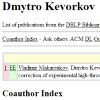| |
 
Olivier Gauthier and
François-Joseph Lapointe. Hybrids and Phylogenetics Revisited: A Statistical Test of Hybridization Using Quartets. In Systematic Botany, Vol. 32(1):8-15, 2007.
Keywords: explicit network, from quartets, hybridization, phylogenetic network, phylogeny, reconstruction, reticulogram, split decomposition.
Note: http://dx.doi.org/10.1600/036364407780360238.
Toggle abstract
"The occurrence of reticulations in the evolutionary history of species poses serious challenges for all modern practitioners of phylogenetic analysis. Such events, including hybridization, introgression, and lateral gene transfer, lead to evolutionary histories that cannot be adequately represented in the form of phylogenetic trees. Although numerous methods that allow for the reconstruction of phylogenetic networks have been proposed in recent years, the detection of reticulations still remains problematic. In this paper we present a Hybrid Detection Criterion (HDC) along with a statistical procedure that allows for the identification of hybrid taxa. The test assesses whether a putative hybrid is consistently intermediate between its postulated parents, with respect to the other taxa. The performance of the statistical method is evaluated using known hybrids of the genus Aphelandra (Acanthaceae) using two network methods: reticulograms and split decomposition graphs. Our results indicate that the HDC test is reliable when used jointly with split decomposition. On the other hand, the test lacks power and provides misleading results when using reticulograms. We then show how the procedure can be used as a tool to identify putative hybrids. © Copyright 2007 by the American Society of Plant Taxonomists."
|
|
| |

François-Joseph Lapointe. How to account for reticulation events in phylogenetic analysis: A review of distance-based methods. In Journal of Classification, Vol. 17:175-184, 2000.
Keywords: abstract network, evaluation, from distances, phylogenetic network, Program Pyramids, Program SplitsTree, Program T REX, pyramid, reconstruction, reticulogram, split network, survey, weak hierarchy.
Note: http://dx.doi.org/10.1007/s003570000016.
|
|
| |
|
| |
|
| |
|
| |

David A. Morrison. Networks in phylogenetic analysis: new tools for population biology. In IJP, Vol. 35:567-582, 2005.
Keywords: median network, NeighborNet, phylogenetic network, phylogeny, population genetics, Program Network, Program Spectronet, Program SplitsTree, Program T REX, Program TCS, reconstruction, reticulogram, split decomposition, survey.
Note: http://hem.fyristorg.com/acacia/papers/networks.pdf.
|
|
| |
 
David Posada and
Keith A. Crandall. Intraspecific gene genealogies: trees grafting into networks. In TEE, Vol. 16(1):37-45, 2001.
Keywords: likelihood, median network, netting, parsimony, phylogenetic network, phylogeny, Program Arlequin, Program SplitsTree, Program T REX, Program TCS, pyramid, reticulogram, split decomposition, statistical parsimony, survey.
Note: http://darwin.uvigo.es/download/papers/09.networks01.pdf.
|
|
| |
  
Alix Boc,
Alpha B. Diallo and
Vladimir Makarenkov. T-REX: a web server for inferring, validating and visualizing phylogenetic trees and networks. In NAR, Vol. 40(W1):W573-W579, 2012.
Keywords: from rooted trees, from species tree, lateral gene transfer, phylogenetic network, phylogeny, Program T REX, reconstruction, reticulogram, software.
Note: http://dx.doi.org/10.1093/nar/gks485.
Toggle abstract
"T-REX (Tree and reticulogram REConstruction) is a web server dedicated to the reconstruction of phylogenetic trees, reticulation networks and to the inference of horizontal gene transfer (HGT) events. T-REX includes several popular bioinformatics applications such as MUSCLE, MAFFT, Neighbor Joining, NINJA, BioNJ, PhyML, RAxML, random phylogenetic tree generator and some well-known sequence-to-distance transformation models. It also comprises fast and effective methods for inferring phylogenetic trees from complete and incomplete distance matrices as well as for reconstructing reticulograms and HGT networks, including the detection and validation of complete and partial gene transfers, inference of consensus HGT scenarios and interactive HGT identification, developed by the authors. The included methods allows for validating and visualizing phylogenetic trees and networks which can be built from distance or sequence data. The web server is available at: www.trex.uqam.ca. © 2012 The Author(s)."
|
|
|
|
 - forked on GitHub.
- forked on GitHub.








